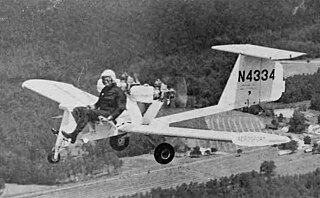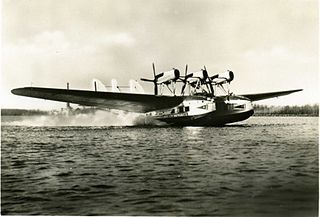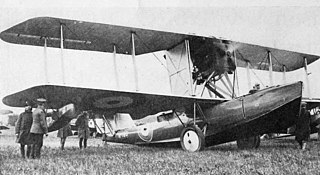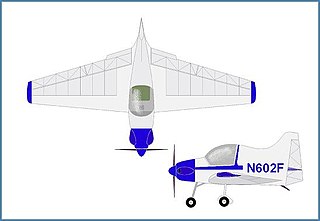Related Research Articles

The Aerosport Rail is an American minimalist ultralight aircraft, designed by Harris Woods and built by Aerosport Inc. The aircraft was first flown on 14 November 1970.

The Fauvel AV.36 was a single-seat tailless glider designed in France in the 1950s by Charles Fauvel. Although the "AV" in AV.36 stands for Aile Volante, it was not a true flying wing: it featured two large fins mounted on stubby tailbooms extending back from the wing's trailing edge, and accommodated the pilot within a stubby fuselage. The aircraft was designed to be quickly disassembled for road transport, with the nose detaching, and the fins able to fold back against the trailing edge of the wing. A refined version with a slightly longer wingspan, the AV.361 was introduced in 1960.
The Supermarine Commercial Amphibian was a British passenger-carrying flying boat designed by Reginald Mitchell and built by the Supermarine Aviation Works.
The Fauvel AV.44 was a design for an unorthodox light aircraft produced in France in the 1970s. The work of Charles Fauvel, it was based on his pre-war AV.10 and like it, was a tailless monoplane with a reverse-delta planform and side-by-side seating in an enclosed cabin. The AV.44 featured considerably more modern aerodynamics and accommodation for two passengers in place of the AV.10's one. Five examples were under construction in 1977.

The Savoia-Marchetti S.66 was a 1930s Italian twin-hull flying boat designed and built by Savoia-Marchetti as an enlarged development of the S.55.

The Hopfner HA-11/33 was an amphibious flying boat built in Austria in 1933 to a specification by the Dr. Oetker company. The result was a conventional, high-wing cantilever monoplane with a stepped flying boat hull and pontoons on struts under the wings at mid-span. The cabin was fully enclosed, and the twin engines were mounted tractor-fashion on struts above the wing.
The Breguet 790 Nautilus was a prototype French three-seat coastal patrol flying-boat designed and built by Breguet Aviation to meet a requirement from the French navy.
The SIAI-Marchetti S.700 Cormorano was an Italian proposal for a twin-engined amphibian based on the SF.600 Canguro.

The SIAI S.51, Savoia Marchetti S.51 or Savoia S.51 was an Italian racing flying boat built by SIAI for the 1922 Schneider Trophy race.

The Boeing XPB was an American twin-engined biplane long-range patrol flying boat of the 1920s. A single example was built for the United States Navy.

The Supermarine Sheldrake was a British amphibian biplane flying boat developed by Supermarine from the Supermarine Seagull with a revised hull. It was powered by a Napier Lion engine mounted between the wings driving a four-bladed propeller. Only one Sheldrake, serial number N180, was built.
The Kawanishi E10K, also known as Kawanishi Type T, Kawanishi Navy Type 94 Transport Seaplane and Kawanishi Navy Experimental 9-Shi Night Reconnaissance Seaplane, was a small Japanese flying boat of the 1930s. It was a single-engined biplane intended to meet a requirement for a night reconnaissance aircraft for the Imperial Japanese Navy, but was not selected for production, the single prototype being converted to a transport and operated as the Navy Type 94 Transport.
The Air Est JCD 03 Pelican is a French mid-wing, twin tailed, flying wing single-seat motor glider that was designed by Jean-Claude Debreyer and produced by Air Est Services of Marly, Moselle and supplied as a kit for amateur construction or as a complete aircraft.
The Progressive Aerodyne Stingray is an American homebuilt flying boat that was designed by and produced by Progressive Aerodyne of Orlando, Florida, introduced in the 1990s. When it was available the aircraft was supplied as a kit for amateur construction.

The Fauvel AV.2 (AV for aile volante was the first Fauvel type to fly, completed in 1932.
The Nihon L7P was a Japanese military seaplane built in World War II in the early 1940s.

The Fauvel AV.10 was a flying wing light aircraft built in France in the mid-1930s.

The Fauvel AV.60 (AV for aile volante was a flying wing tourism aircraft built in France in the early 1960s. It was a low-wing monoplane of wooden construction, featuring a flying wing layout.
The Fauvel AV.42 was a (AV for aile volante was a tail-less tourism cabin monoplane designed, but not built, in France.
The Fauvel AV.29 was a design for a transport plane by Charles Fauvel in the late 1930s.
References
- 1 2 "Charles Fauvel and his Flying Wings". www.nurflugel.com (in French). Retrieved 1 March 2019.